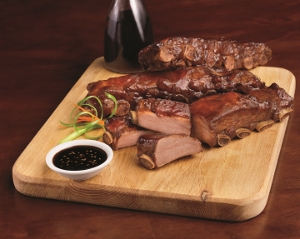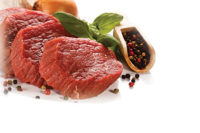 Thirty-one percent of people surveyed in AMI/FMI’s Power of Meat 2012 study said that they regularly cut down on portion sizes of meat and poultry as one of their healthy eating strategies. Another 52 percent said they occasionally do. In addition, women report above-average focus on portion control, limiting second helpings and even increasing the number of meatless meals.
Thirty-one percent of people surveyed in AMI/FMI’s Power of Meat 2012 study said that they regularly cut down on portion sizes of meat and poultry as one of their healthy eating strategies. Another 52 percent said they occasionally do. In addition, women report above-average focus on portion control, limiting second helpings and even increasing the number of meatless meals.
The data shows that portion-controlled meat and poultry offerings at retail are absolutely significant to consumers as they look for better management of their weight and think about their health, says Michael Uetz, principal at Midan Marketing, Chicago.
“Consumers continue to tell us they are very conscious about their health,” he says. “They generally seem to follow through on that, but certainly it is a top-of-mind driver for them when they shop for groceries in general.”
Although particular hot-button health issues come and go, consumers consistently have been interested in protein for the broad range of nutrition and lasting energy it provides, adds Natosha Walsh, brand manager for Hormel Compleats meals.
The importance of protein is gaining along with consumers’ knowledge of nutrition, but consumers’ desire for portion-controlled products is not necessarily about watching their weight, says Greg Pang, senior ethnographic analyst at The Hartman Group Inc., Bellevue, Wash. “They don’t want food to go to waste,” he says.
|
Quality slicing Slicing consistency comes from operating consistency. By Elizabeth Fuhrman The ability to slice a piece of protein well isn’t full of any big secrets, but the ability to manage all the different skills and processes to accomplish slicing do add up. Well-sliced protein will remain intact, have consistency in the thickness of slices and won’t shred apart when taken out of the package. This begins in the formulation and cooking process of the protein and can be accomplished by using suitable slicing machinery and packaging machines. Processors also are concerned with their customers’ required or desired slice thicknesses. Palmyra Bologna Co., of Palmyra, Pa., produces about 125,000 pounds a week of Lebanon bologna, of which it slices approximately 50,000 pounds per week. Everything the company slices is vacuum-packaged in 6-ounce, 8-ounce, 12-ounce and 1-pound packages, in addition to bulk slicing it does for area retailers. Palmyra Bologna normally yields 22 slices per pound, which amounts to about three-quarters of an ounce per slice. The key to the company’s slicing is operating proper equipment for the task, says Ron Fouche, who handles Palmyra’s quality control. The company can currently slice up to 100,000 slices a minute. To maintain the equipment, throughout the day, Palmyra’s elliptical blades are checked and sharpened at breaks and lunchtime. “Not much has changed over the years,” Fouche says. “You’ve got to have decent equipment, you have to maintain it and you’ve got to have a sharp blade.” When slicing deli meats, the temperature of the product at the time of slicing also greatly affects the finished product. “We target to have a consistent temperature of 28 degrees to 29 degrees Fahrenheit throughout the slicing log,” says Ken Neishi, vice president of operations at Columbus Foods, Hayward, Calif., which processes premium specialty meats. “When slicing salame, the temperature of the product at the time of slice is also important, along with the moisture content. … If the salame is too dry, wet or soft, it can affect the yield and product quality.” Sliced product is considered ready-to-eat, and food safety is always a primary concern. Thus, it is essential to have very tight controls on the slicing environment, Neishi says. Properly trained operators also are key to efficient and effective slicing and sanitation, Fouche adds.Another key to slicing is weight control. Palmyra operates a slicer with two scales. “I don’t want to ever be underweight,” Fouche says. Product yield is a challenge Columbus Foodsaddresses head-on. “Due to our high-quality standards of sliced product, we strive to reduce the amount of product that goes to waste,” Neishi says. Columbus Foodsrecently updated its slicing technology with items that includea new camera system on its slicing machine, robotics for packaging sliced meats into the packaging trayand automatic loading of the slicing logs into its slicer. The company also currently has a patent pending on a high-pressure processing (HPP) solution that it developed for slicing. In 2011, Columbus Foods developed a modified-atmosphere packaged (MAP) product that could go through the HPP process, Neishi says. |
Another reason for the increase in portion-controlled proteins is catering to consumers’ need for convenience in having the exact portion needed for their family, says Kent Harrison, vice president of marketing premium programs at Tyson Fresh Meats.
“Also we’re seeing, with increased costs that we’ve had in our industry, the rising costs of meat across the board,” he says. “I think that consumers are more conscious about buying the right amount that they need. By having things portioned out, they have more confidence that they have exactly what they need for their occasion planning.”
Uetz agrees; the big driver that processors and retailers need to consider is price.“Our meat department challenge is, how do we try to balance the fact that on a price-per-pound the cost may go up for a smaller portion size and that health image for customers while they are also very conscious on price,” he says. “The key is how do we define value for our individual customers? How do we truly understand what their needs are and really put together a program that goes right at what their own value equation is?”
Catering to customers
The fresh meat case might be a bit behind in understanding the shift in demographics and responding to consumers who might not need the traditional package sizes.
“There is a lot of opportunity for us to do better,” Uetz says. “We could see more single- and two-serving packages of product that are put out in the meat case to satisfy a demographic that is very quickly shifting to kind of the extremes, where we’ve got a lot of young single shoppers. … On the other extreme we’re seeing an increasing number of Baby Boomers who are moving into retirement and the years where it’s either one- or two-person households.”
Regardless of household composition, any consumer might dine alone due to schedules and other factors, but an increase in the number of single-person households also has occurred.
“The share of single-person household was 28 percent in 2010, up from 13 percent in 1960,” says Hormel’s Walsh. Inspired by the continued popularity of portion control offerings, Hormel Compleats aim to provide consumers with balanced portions for the single-serve occasion.
A trend that Hormel has seen, and Walsh predicts will continue to see, is an interest in creative flavors offering to complement the protein element in a meal.
“This is particularly true of the single-serve occasion, when the consumer can indulge in a flavor that they particularly enjoy,” she says. “Consumers look to experience new cuisines and flavors, along with familiar favorites in single-serve meals.”
Tyson Fresh Meats also has been creating family-portioned products that have flavorful seasonings and marinades to develop convenient, healthy and interesting products for families.
“One of the things that we just recently launched is our Sparerib Mini Racks, and what those are is taking what is a standard sized St. Louis-style spare rib, which can be fairly large and daunting and cutting that into usable quarters,” Harrison explains. “It works out to have just perfect-sized portions that you can easily package and label to perhaps overcome a little bit of intimidation around that category of product.”
Another concern is managing the amount of the ring size at retail and having the right portion size to hit a price point.
“Sometimes there is a fantastic piece of meat, like a whole tri-tip, that is a great thing to use for a meal occasion, but with today’s market pricing of the product, it becomes a little bit higher cost in terms of the total ring at retail,” Harrison says. “One of the things that we’ve done is cut that particular cut in half under our Backyard Flavors line and provide that option for retailers to be able to go to market with either the whole tri-tip or the half tri-tip — essentially cutting the overall cost at the counter in half.
While many consumers do want smaller packages, others are willing to buy protein in bulk if the protein is portion-cut into meal-sized quantities.
“That idea of really buying a big hunk of meat and doing the work yourself doesn’t appeal to them too much,” Harrison says.
Consumers are more willing to buy bulk product if it’s been packaged individually and then bundled together, he says. In addition, Harrison believes it would be a great merchandising opportunity if retailers started promoting services such as free slicing or cutting whole sub-primal cuts in portion sizes for consumers and repackaging them for easy take-home.
Packaging also has been a big driver of innovation in the meat case. Resealable packaging has become more readily available in the fresh meat case, which has allowed self-controlled portioned offerings, Uetz says. Perforated packaging, in which a package might include eight or nine individually packaged proteins that can be torn apart, also is becoming more prevalent.
“I think those are going to continue to be significant,” Uetz says. “It allows you to buy a lot of product at a reduced price because you are buying in volume, but it allows for very easy freezing and being able to pull out just as much as you need for a particular meal occasion.”
Protein prices are probably going to be the greatest factor affecting portion-controlled offerings ahead, because portion sizes tend to go against a reduced price per pound.
“If we can think about value and understand who our customer base is, this is going to help the industry, because we can really work on that value equation; and that’s how we get customers over the fact that they are paying a little bit more,” Uetz says. “If we can cater to their needs, that whole pricing issue becomes less of an issue for them.”





Report Abusive Comment